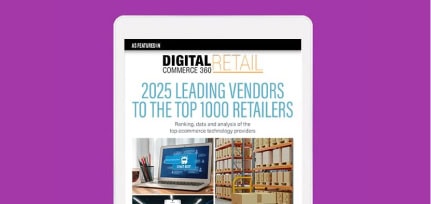Industry experts and everyday mobile users have awaited the release of 5G for several years. The widespread use of 5G technology is set to create another technology boom once released into the entire smartphone ecosystem. Set for arrival this year, 5G has sparked a combination of anticipation and anxiety in consumers and experts around the world. Some people can’t wait to explore all the digital possibilities, while others wonder if we need additional computing power.
Right now, 5G is mostly tied up in future speculation. Ecommerce leaders can work with what we know about 5G to enhance their omnichannel and mobile retail strategies. This article is an introduction to how the new technology will touch retail, and should open doors for those looking for answers about how to best apply 5G technology to their commerce operations.
- After a limited test rollout in major U.S. cities in 2019, 5G is set for broader release and adoption in 2020.
- 5G is poised to enhance the consumer experience with higher speeds, lower latency, improved bandwidth and better overall reliability.
- The new technology will boost ecommerce revenue by $12 billion by 2021 — but in the face of security issues and adoption difficulties, it’s not a slam dunk.
How 5G will enhance mobile commerce
Commercial 5G growth is expected to be huge for the retail industry. The promise of faster speeds, lower latency, better reliability and improved bandwidth has retailers clamoring to cash in on the possibilities for enhancing mobile ecommerce experiences.
Faster speeds and lower latency factors provide smoother shopping experiences in retail transactions. 5G networks are expected to increase data speed by up to three times the current rate of 4G/LTE, according to Technative. In a world where customers will abandon their cart after a two-second page load wait, every fraction of a second counts.
A quick look at Cyber Week 2019 shows how important mobile experiences have become: 65% of all ecommerce orders came from a mobile device on Black Friday, with $2.9 billion on sales from smartphones alone, according to Salesforce and Adobe. 5G is arriving on the scene just in time to help online merchants meet and exceed customer needs and demands.
Speed is key in winning ecommerce sales, but it’s important to have as much information as possible before going all in on 5G for retail. Be aware of the issues surrounding the technology’s adoption and expansion to avoid costly mistakes.
5G is already huge, and it’s not fully here yet
Market analysis suggests that the response to 5G is already overwhelmingly positive. In September 2019, Research and Markets reported that “the global 5G technology market will be valued at $5.54 billion in 2020 and is projected to reach $667.9 billion by 2026.” The projection indicates a potential 122.3% increase from 2020 to 2026.
As of January 2019, several cities launched 5G as part of a trial rollout via several different mobile carriers. A few of the trial rollout cities included:
- Houston, TX
- Los Angeles, CA
- Indianapolis, IN
- Jacksonville, FL
- Atlanta, GA
- Louisville, KY
- New Orleans, LA
- Raleigh, NC
- Dallas, TX
The release covered several large markets across the U.S. to gain insights into how 5G will work in areas with enterprise-rich and consumer-saturated populations. Gartner predicts that more than half of organizations will implement 5G by the end of next year, but with a caveat that could stunt growth.
Gartner’s research indicates that the new network is not yet widespread enough to support the majority of desired business use cases, an issue that is likely to drag on into the year 2022. Solutions include core slicing, radio network densification and edge computing — very complex technical asks that are likely beyond the skillsets of most ecommerce leaders.
The best answer to this conundrum is to work with experts who deal specifically in mobile and 5G technology to address specific business concerns before pouring in a chunk of the budget to developing 5G-centric strategies. But stay awake and aware: delays are no excuse to ignore how 5G will become an essential part of mobile retail.
Where 5G adoption and expansion still need work
The expected high rates of speed and lowered latency promise a variety of technology releases and adoptions. However, speed alone can’t support seamless usage of innovations in AI, IoT and augmented reality (AR)/virtual reality (VR). Many businesses currently lack the infrastructure to support these exciting new cases, so trying to invest in an even more complex version without guidance is a hard sell.
With the available 5G speed, developers will have a better environment to test developing technologies while enhancing their existing infrastructure. The future is coming at us fast. It just requires a bit more patience. There are a few key concerns and issues surrounding the adoption and expansion of 5G:
- Consumer security concerns. 5G security concerns are mounting after researchers at Purdue University and the University of Iowa found 11 vulnerabilities in the next generation cellular networks, according to Forbes. Among the threats uncovered in the Forbes report are “stingrays”, which present themselves as a cell tower to spy on users — a scheme that existed on previous 3G and 4G networks.
- The network coverage is a vulnerability. A Wired report demonstrated the unique vulnerability tied to the expansion of the 5G network itself. Some flaws in 5G allow for “downgrade” attacks, where a target’s phone connection is manipulated to downgrade to 3G or 4G service. That’s an easy way for hackers to use unresolved flaws in older networks to carry out cyber attacks.
- Large-scale cybersecurity issues. With expanded 5G deployment proposed, many businesses eagerly await adding new services to their systems. But every piece of the new puzzle can be unpredictable. Cybercrime must be top of mind for retail leaders seeking to add 5G to their company tech stack.
These should be seen as a caution sign, not a stop sign. 5G is worth the investment, but not without due diligence and research. The retailers that understand where 5G is now as much as they understand where the technology is going will remain in the lead of the mobile retail race.
The future of 5G in retail
Pay attention to two big numbers that relate to 5G: $12 billion and $80 billion. According to a recent Adobe Digital Insights report, 5G will boost ecommerce revenue by $12 billion by 2021, Goldman Sachs predicts that the global virtual reality (VR) and augmented reality (AR) market is predicted to be worth $80 billion by 2025.
Smartphones and other personal devices will continue to drive retail growth and innovation. Retail Dive shares a list of ways retailers are using AR technology to enhance their omnichannel customer experience and supply chain management, like J.C. Penney’s virtual fitting room improving conversions and reducing returns, IKEA’s in-room product visualization that gives customers a real-time, to-scale view of the product in their homes and SAP’s warehouse navigator that streamlines space management and inventory for better fulfillment.
5G is expanding to more cities every day. Consumers are eager for the better, faster mobile service, and retailers are banking on the technology as a way to boost revenue. First movers may not have every advantage when it comes to harnessing the power of 5G’s impact on retail. It’s all about making the smart moves that work best for your business.








